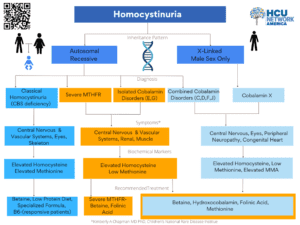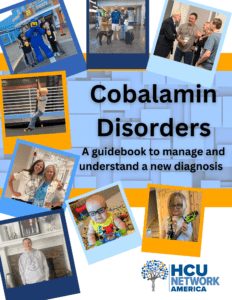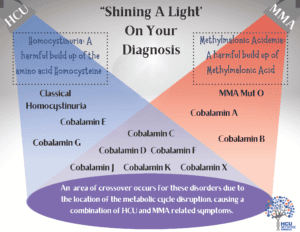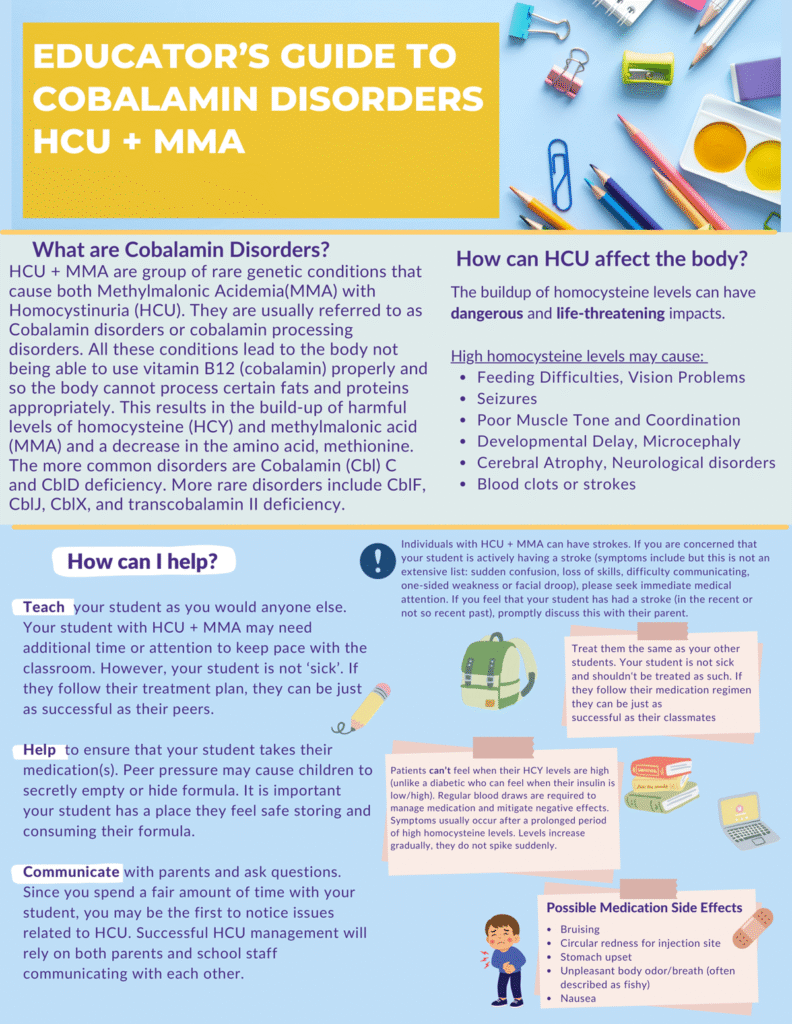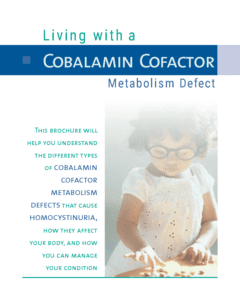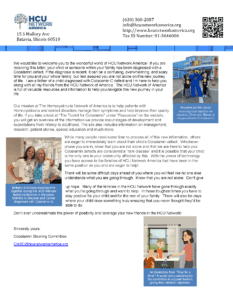
Whether you are a parent of a newborn or a child, or you are an adult just diagnosed, we know it can be overwhelming. Consider HCU Network America a friend and a resource who will provide comfort, and more importantly guidance every step of the way.
Homocystinuria is confusing! The HCU Flow chart is designed to help those related to someone with or interested in HCU better understand the similarities and differences. The chart breaks down and shows how the inheritance, symptoms, markers, and treatments for each of the disorders are similar and different.
The New Diagnosis Guide for Cobalamin Disorders is designed to give you an over view of what the cobalamin disorders are, how it's treated, who might be involved in your care and support networks for families.
The information in this toolkit is not meant to replace the guidance of your physician and other healthcare professionals.
The metabolic pathways for the homocystinurias (HCU) and methylmalonic acidemias (MMA) are very confusing! While a majority of the cobalamin disorders are a combination of both HCU and MMA, not all are. This leads to a very distinct different type of treatment protocol for those who have a combined form. Knowing the type of Cobalamin disorder you have is important to ensuring your treatment best suites you!
Having a cobalamin diagnosis can be overwhelming and you may not know all the questions to ask - that's okay!
In 2008 Sloan et. al published the first Gene Review of Disorders of Intracellular Cobalamin Metabolism. The publication summarized the characteristics, diagnostic testing, management and more of Intracellular Cobalamin disorders. This continues to be updated.
Then in 2016, the Guidelines for Diagnosis and Management of the Cobalamin-related Remethylation disorders was also published.
We have summarized their monitoring recommendations in this handy infographic.
Hydroxocobalamin can be injected both subcutaneously and intramuscularly. While both have proven to be effective, they both have different absorption rates, advantages, and disadvantages and require different injection sites. It's important when you are injecting that you understand the differences and advantages.
The “All About Me” pamphlet is a great tool to help people understand your child, their condition, and how to help them to be as successful as possible in life! The pamphlet is generally built for a school setting, but it also is a great way to inform babysitters, coaches, and family members about critical things that are very important to your child. Some people may be afraid to ask some of these fundamental questions about your child and their disorder, but this pamphlet makes it simple to convey that information.
Our Educators’ Guide to Methylmalonic Acidemia with Homocystinuria (MMA+HCU) is designed to spring-board that discussion between you, the school nurse and classroom teacher(s). In our Educators’ Guide we give you an easy explanation of MMA+HCU, how high levels may impact your child, how teachers and nurses can help, possible medicine side effects, helpful tips for success, and educational accommodations and additional services that might benefit your student. We know that teachers don’t have a lot of time, so this two page guide is the perfect amount of content to help get the conversation started.
Our Educators’ Guide to Cobalamin E (CblE) and Cobalamin G (CblG) is designed to spring-board that discussion between you, the school nurse and classroom teacher(s). In our Educators’ Guide we give you an easy explanation of CblE and CblG, how high levels may impact your child, how teachers and nurses can help, possible medicine side effects, helpful tips for success, and educational accommodations and additional services that might benefit your student. We know that teachers don’t have a lot of time, so this two page guide is the perfect amount of content to help get the conversation started.
When you have HCU or any other special dietary needs, being ready to handle difficult situations requires special planning, in addition to the typical things everyone needs to consider in the event of an emergency or natural disaster. Here are some key things to think about and discuss with your family today.
Prepare yourself in advance!
Special Education services are available for eligible students with disabilities. This handbook provides information about procedures, answers to frequently asked questions, and links to other resources. This information is meant to be an introduction to special education and may vary between states. For specific laws and regulations to special education in your state, visit your State Department of Education.
A Social Story: Time for A Shot
Navigating a rare disorder is full of challenges; but you don't need to do it alone. As a community of families with patients diagnosed with Homocystinuria Cobalamin defects, our goal is to support and provide resources to help you care for yourself and your child.
Giving a young child a shot can cause a lot of stress and anxiety, for all involved. We hope this social story will help provide an opportunity for you to teach your child why they need to get a shot, how to ease the process and educate them on the importance of medication management.
Transition to Adulthood: Milestones Assessment Guide
Thanks to advances in research, people with homocystinuria are living healthier and more active lives than ever before—juggling busy schedules, careers and family. If they aren’t doing these things, that’s okay too; life doesn’t always look the same for everyone.
This guide is intended to help people with homocystinuria gain the knowledge and skills they need as they grow up to more independently manage their condition. Our flexible toolset is designed for people with homocystinuria to use with their caregivers and care teams to support the transition from childhood to adulthood.
Would you like to request a physical copy of any of the tools seen above?
Fill out the form below and we are glad to send you physical copies.
Outside Resources
Homocystinuria caused by cobalamin cofactor metabolism (cbl) defect occurs when the body cannot properly process cobalamin (vitamin B12). This infographic walks you through the effects of the Cbl, symptoms, inheritance pattern, how it's diagnosed, specialist included in treatment and what patients lives look like if treated early!
Homocystinuria caused by cobalamin cofactor metabolism (cbl) defect occurs when the body cannot properly process cobalamin (vitamin B12). This activity is essential for converting an important amino acid—homocysteine—back to methionine, another important amino acid. When the body cannot process vitamin B12 as it should, blood levels of homocysteine increase, and blood levels of methionine decrease. This causes harmful symptoms to develop.

E-HOD consortium developed information booklets on homocystinurias and related diseases for children of school age and for adults/carers. Booklets in different languages are available for free download and non-comercial distribution under flags shown below.
